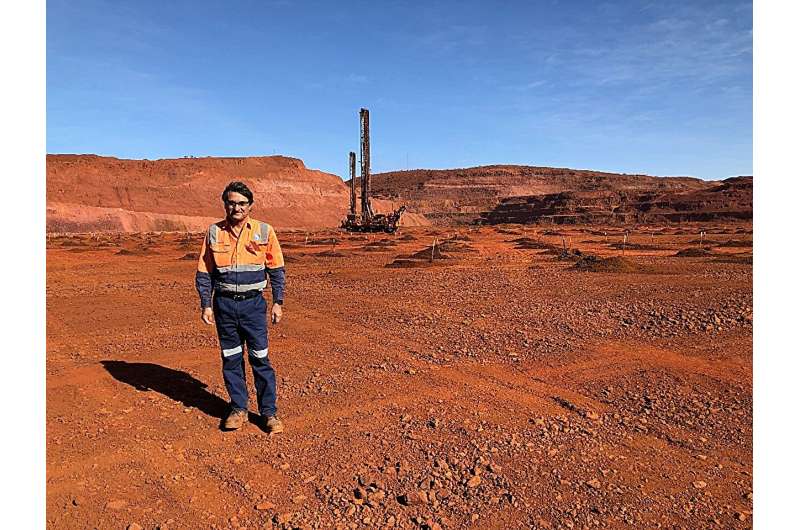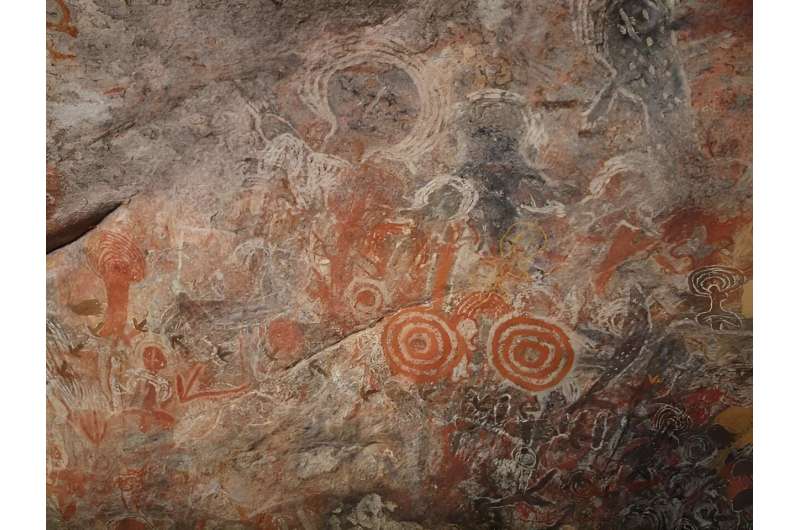This article has been reviewed according to Science X's editorial process and policies. Editors have highlighted the following attributes while ensuring the content's credibility:
fact-checked
trusted source
proofread
Rust to riches: Goethite's role in shaping Australia

Have you noticed many Australian landscapes, like the outback and our deserts, are brown and orange? This is especially easy to see when looking at a satellite image. Australia's red center is colored by an abundant mineral scorched into Australian soils and sediments.
Goethite (pronounced ger-thahyt) is an iron-bearing mineral. It is an important source of iron oxide on Earth. It's also a historically and culturally important mineral for Australia.
It has been used by humans for thousands of years in different forms and continues to support Australia's economy today.
How is goethite formed?
Goethite forms when iron-rich minerals weather and become oxidized. It is the main component of rust, and gives color to many Australian soils, rocks and landscapes.
The formation of goethite in Australia is closely tied to our unique geological history. About 2.6 billion years ago, Earth's atmosphere lacked oxygen. The oceans contained high levels of dissolved iron. Over millions of years, photosynthetic bacteria started releasing oxygen to the oceans and atmosphere, kick-starting the process of oxidation.
This led to the precipitation of a special kind of rock. Banded iron-formations (BIF), are a beautiful rock made of several iron minerals, including magnetite and hematite. The minerals create bands alternating with gangue, which are the impurities closely mixed with a wanted mineral in an ore deposit.
Dr. Erick Ramanaidou is one of our experts in iron ore and lateritic nickel. He says that this ancient process laid the groundwork for the immense goethite deposits that we find in Australia today.
"Five million years after the mass extinction event that killed off the dinosaurs, at the end of the Cretaceous 65 million years ago, the gangue minerals of the BIF were replaced by goethite," Erick says.
Goethite can be found in various geological formations including lateritic deposits and weathered BIFs. It also forms delicate stalactites and stalagmites in caves.
"In Australia, goethite is predominantly associated with the vast iron ore deposits of the Hamersley Basin in Western Australia," Erick says.
Goethite is also found in other iron ore regions such as the Pilbara, Yilgarn, and the Middleback Ranges.
NASA even found goethite on Mars, where it helps them study the history of water on the planet.
Pigment for Paleolithic paint
Humans have used goethite since paleolithic times. They used yellow ochre pigment to create cave paintings and body art. It is still used by many cultures around the world in the same ways. Australia's indigenous groups continue to source and use goethite pigments for traditional works.
Today, goethite appears in everything from iron oxide pigments to color paints, as food colorants, in cosmetics and more.

Scorched into Australian soils
When goethite-rich soils and bushfires come together, something peculiar happens. The high temperatures of the bushfire transform the goethite into maghemite. This is a magnetic mineral that can be seen in soils in many parts of Australia.
Iron ore for steelmaking
Goethite is the main mineral in iron ore, which is used to make steel. Australia is the world's largest iron ore exporter and demand is expected to grow. Our red center is central to our economy.
Iron ore is Australia's largest source of export revenue. In 2022, we produced a whopping $120 billion in iron ore exports. The industry is also a major employer. Around half of the 130,000 people directly involved in mining in Western Australia work with iron ore.
The Hamersley Province of Western Australia is unique. It contains two major types of iron ores which provides 40% of worldwide iron ore production. These iron ores are called martite goethite (M-G) and channel iron deposits (CID). They contain about 50% to 60% goethite.
Discovering and understanding iron ore deposits is critical to ensure our iron ore exports thrive. It's also important for Australia to think about the emissions our iron ore produces once it enters the steelmaking process.
Our Towards Net Zero mission is exploring low emissions steel making processes that bring together our innovative ore processing expertise and our renewable energy potential.
Provided by CSIRO




















